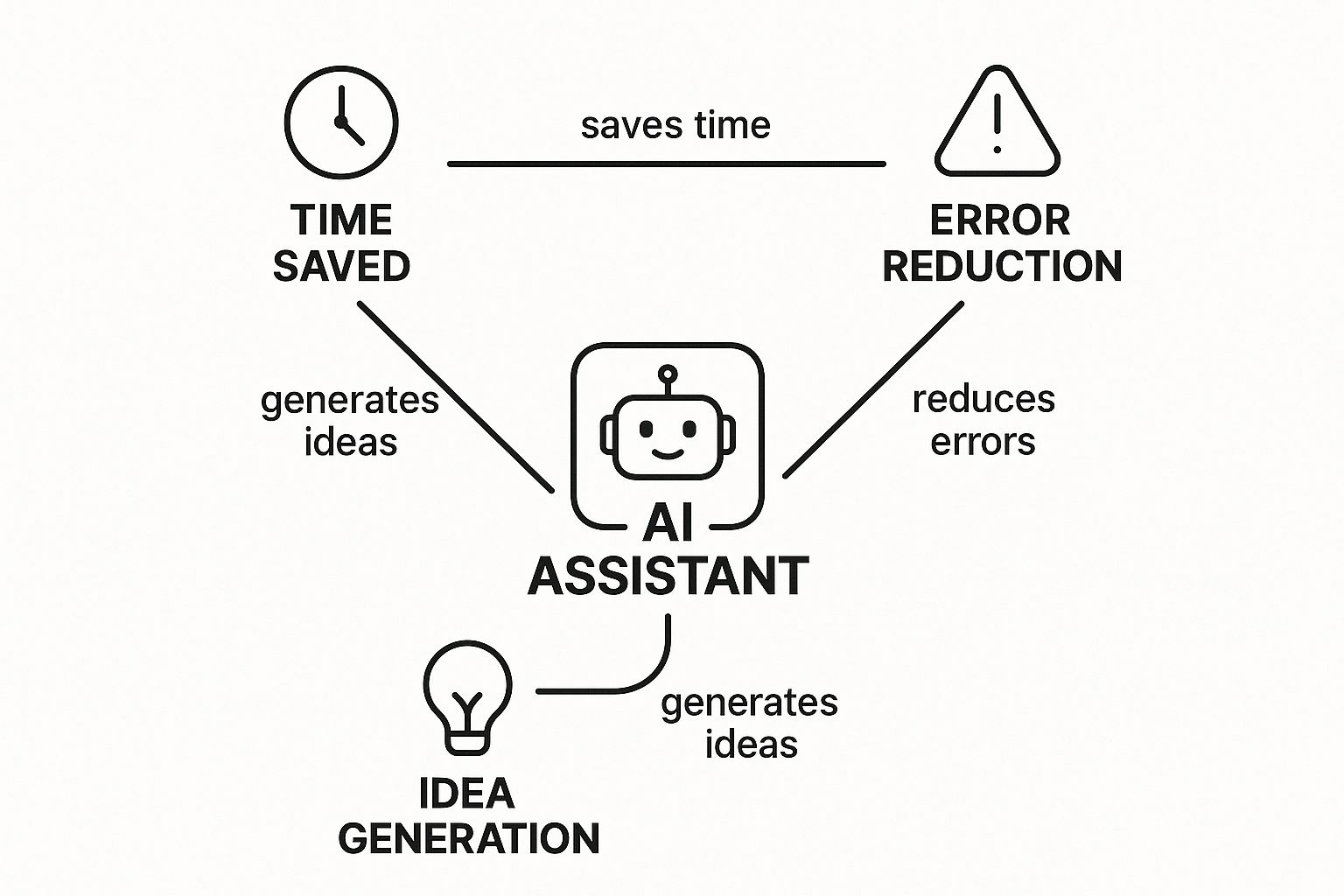Understanding AI Writing Assistants Beyond the Hype

This screenshot shows the ChatGPT interface. Users type in prompts and receive AI-generated text. The clean design emphasizes the conversational aspect of the tool. It encourages back-and-forth interaction with the AI, making writing feel more collaborative. The interface also highlights the simplicity of using these tools.
Forget the image of robotic overlords replacing human writers. Think of AI writing assistants more like eager, knowledgeable interns. They can draft text, suggest edits, and even brainstorm.
But just like interns, they need guidance. They need a human touch to polish their work into something truly excellent. The difference between assistance and automation is crucial to understanding the real value of AI writing tools.
The current buzz around AI writing assistants is justified. They offer the potential to improve workflows and boost productivity for writers at all levels. Imagine having an assistant instantly generate multiple product descriptions or refine the tone of an important email.
This support frees up time, allowing writers to focus on more creative work. Instead of getting bogged down in tedious tasks, they can concentrate on the bigger picture.
This growing interest translates into a rapidly expanding market. The global AI writing assistant software market is projected to jump from USD 1,750 million in 2024 to USD 10,298 million by 2032.
This impressive growth is fueled by advancements in Natural Language Processing (NLP) and machine learning. These advancements are constantly refining the accuracy and usability of AI writing software. Discover more insights about this growing market. This potential for growth underscores how AI is becoming integrated into writing, from blog posts to academic papers.
AI writing assistants aren't a magic bullet. Their effectiveness depends on the user understanding their capabilities and limits. By looking past the hype and understanding how these tools work, users can truly unlock their potential. Let's explore the inner workings of this exciting technology.
How AI Writing Technology Actually Works in Practice
Ever wonder how your AI writing assistant can sometimes nail your intent, and other times miss the mark entirely? It all comes down to how these systems learn and process language. Think of it like teaching someone to read by showing them countless examples of written words. That's similar to how neural networks, the brains behind AI writing assistants, operate. They analyze huge datasets of text and code, picking up patterns and relationships between words. This training allows them to grasp grammar, style, and even the subtle nuances of context.
The screenshot below provides a glimpse into the world of Natural Language Processing (NLP), the engine that drives AI writing assistants. It illustrates the complex interplay between computers and human language.  This image highlights the extensive research and development required to make AI understand and generate text that sounds human. This complexity allows AI writing assistants to go beyond simply stringing words together; they create coherent and contextually relevant content.
This image highlights the extensive research and development required to make AI understand and generate text that sounds human. This complexity allows AI writing assistants to go beyond simply stringing words together; they create coherent and contextually relevant content.
Context is King: Remembering and Responding
Armed with this foundational knowledge, AI writing assistants use what they've learned to predict the next word in a sequence. It's a bit like the predictive text on your phone, but vastly more sophisticated. For instance, if you begin a sentence with "The cat sat on the...", the AI might predict words like "mat," "chair," or "fence." This predictive ability stretches beyond single words to entire phrases and paragraphs.
This is where context plays a critical role. Modern AI writing assistants maintain a kind of “memory” of the preceding text. This allows them to generate content that flows naturally and logically. They can “remember” previous parts of your conversation or document, ensuring consistency and relevance in their responses. Many AI writing assistants also incorporate feedback loops, learning from your edits and refinements to improve their performance over time.
Let's explore the core technologies that power these tools in more detail:
To illustrate this better, take a look at the table below:
| Technology | What It Does | User Benefit | Real-World Example |
|---|---|---|---|
| Natural Language Processing (NLP) | Enables computers to understand, interpret, and generate human language. | Allows AI to understand your writing prompts and create human-like text. | Analyzing customer reviews to understand sentiment. |
| Machine Learning (ML) | Allows AI to learn from data without explicit programming. | Enables the AI to improve its writing over time based on user feedback and data analysis. | An AI writing assistant learning to suggest better synonyms based on past edits. |
| Deep Learning (DL) | A subset of ML that uses artificial neural networks to process information in complex ways. | Powers the predictive capabilities of the AI, allowing it to generate more sophisticated and nuanced text. | Predicting the next word in a sentence based on the context of the entire paragraph. |
| Large Language Models (LLMs) | Trained on massive datasets of text and code to understand and generate human-like language. | Provides the AI with a vast knowledge base to draw from when creating content. | Generating different creative text formats, like poems, code, scripts, musical pieces, email, etc. |
As you can see, various interconnected technologies contribute to the functionality of AI writing assistants. Each plays a crucial role in enabling these tools to understand and generate human-like text.
The infographic below visualizes key benefits: Time Saved, Error Reduction, and Idea Generation.  As illustrated, AI writing assistants empower writers to be more efficient. This translates to more time for creative work. Check out our guide on grammar checkers for more writing tips.
As illustrated, AI writing assistants empower writers to be more efficient. This translates to more time for creative work. Check out our guide on grammar checkers for more writing tips.
When you click "generate," the AI isn't randomly assembling words. It uses its knowledge of language, the context you provide, and its predictive abilities to craft text that meets your needs. Understanding this process helps you write better prompts and get the most from your AI writing assistant.
Essential Features That Transform Your Writing Process

This image shows a sleek AI writing assistant interface. Its design prioritizes ease of use and clear functionality, making writing feel more intuitive.
Think of all the features packed into your smartphone. Some you use every day; others, not so much. AI writing assistants are the same. Some features are game-changers for your writing; others are just bells and whistles. This section explores the must-have features that will actually boost your writing.
Grammar and Tone: Precision and Persuasion
Intelligent grammar correction is essential. It's not just about catching typos. A good AI assistant analyzes your writing's context to suggest improvements that make your writing clearer and more fluid. Think of it as having a meticulous editor looking over your shoulder.
Tone adjustment is another powerful tool. It lets you tailor your writing to your audience. A formal email? A casual blog post? This feature helps you strike the perfect tone. For instance, consider how useful AI is becoming for crafting social media content: AI generated captions.
Beyond the Basics: Expanding Your Toolkit
Now, let's talk about some more advanced features. Chat Ask AI lets you have a conversation with the AI. You can brainstorm, bounce ideas around, and get instant feedback. It's like having a virtual writing buddy.
Humanize AI takes things a step further. It polishes the AI-generated text to make it sound natural and engaging. It gets rid of that robotic feel that some AI writing can have.
The market for AI writing assistants is vast, encompassing individuals, businesses, and organizations. These tools offer a wide range of features, from grammar and spelling checks to plagiarism detection and style suggestions. However, challenges remain, including data privacy, regulatory complexities, and limitations in understanding nuanced contexts. You can delve deeper into this topic here: AI writing assistant software market.
Time Savers and Creative Boosters: Features That Matter
AI writing assistants can be huge time-savers. Content repurposing is a prime example. It can quickly transform a blog post into social media snippets or condense a long article into a concise summary. This lets you create different content formats efficiently.
For students, features like essay writing assistance and automated citations can be incredibly valuable. They free up time for research and deeper analysis. If you're a student, you might find this helpful: essay writer features.
Let's not forget idea generation. Ever have writer's block? Some AI assistants can offer suggestions, create outlines, or even generate entire drafts based on your keywords. This can be a huge boost for your creativity.
To help you navigate the world of AI writing assistants, here's a handy table comparing essential features with those that are nice-to-haves:
AI Writing Assistant Features: Essential vs. Nice-to-Have
A practical comparison of AI writing features categorized by importance and real-world utility
| Feature | Category | Daily Use Value | Best For | Skip If |
|---|---|---|---|---|
| Grammar and Spelling Correction | Essential | High | Everyone | You're a grammar whiz |
| Tone Adjustment | Essential | High | Content creators, marketers, business writers | You only write in one style |
| Content Repurposing | Essential | High | Content creators, marketers | You only create one type of content |
| Plagiarism Detection | Essential | Medium | Students, academics, content creators | You write highly original content |
| Idea Generation | Nice-to-Have | Medium | Bloggers, writers, content creators | You're never short on ideas |
| Chat Ask AI | Nice-to-Have | Medium | Writers needing brainstorming support | You prefer solo brainstorming |
| Humanize AI | Nice-to-Have | Medium | Anyone concerned with AI-sounding text | You enjoy a more formal style |
| Automated Citations | Nice-to-Have | High | Students, academics | You manually cite sources |
This table highlights the core features you'll likely use daily and those you might not need. Focus on the essentials for maximum impact.
AI writing assistants are becoming indispensable tools for writers of all kinds. By choosing the features that fit your writing goals, you can significantly improve your workflow and reach your creative objectives. These tools empower writers to focus on what truly matters: creating compelling content.
Major Players Shaping the AI Writing Landscape
The AI writing assistant field is a bit like the Wild West right now. Think bustling gold rush towns, with big established companies setting up shop alongside scrappy prospectors. These smaller, nimble startups are often laser-focused on solving very specific writing problems exceptionally well. This creates a dynamic and exciting market where users benefit from both powerful general-purpose tools and highly specialized solutions.
Giants and Specialists: Different Approaches, Different Strengths
Think of companies like OpenAI (with its famous ChatGPT) as the established general stores in our gold rush town. Microsoft and Google, with their deep pockets and existing infrastructure, are like the railroads and banks, powerful forces shaping the landscape. These giants use massive datasets and powerful computing to create AI writing assistants that can handle a wide variety of writing tasks. They're a great starting point for anyone new to AI writing.
But sometimes you need a specialist, right? That's where the smaller companies come in. They're like the blacksmiths and assayers of our town, catering to specific needs. Some might excel at generating marketing copy (think persuasive saloon ads!), while others focus on academic writing or crafting imaginative fiction (like the town's storyteller). Check out resources like AI content creation tools to explore these niche tools. This specialization allows them to offer features the larger, more general-purpose tools might not have.
Market Dynamics: Innovation vs. Brand Recognition
The market share reflects this mix of big names and up-and-comers. OpenAI holds about 28% of the market, Anthropic 17%, Microsoft 14%, and Google 12%. Together, these four control over 70% of the market. However, innovative startups like WriteMind AI are quickly gaining ground, grabbing an 8% market share in just a couple of years. You can find more information on the AI writing assistant market here. This shows that while name recognition is important, users also value genuine innovation and practical value.
Choosing Wisely: Beyond the Hype
When choosing an AI writing assistant, it's important to look beyond the shiny marketing. Some companies are true innovators, constantly pushing the boundaries of what's possible. Others rely more on marketing hype than actual performance. Understanding these market dynamics will help you choose the right tool for your specific needs and goals. The following sections will dive deeper into the applications of AI writing and guide you through selecting the perfect fit for your workflow.
Real Success Stories Across Different Writing Contexts
An AI writing assistant isn't a one-size-fits-all solution. Think of it like a set of adaptable tools in a writer's workshop – a novelist might reach for a thesaurus, while a journalist might use a fact-checking database. Similarly, different writing needs call for different AI assistance features. Let's explore how these tools make a real difference in various writing situations.

This screenshot shows Grammarly's interface. Notice how it focuses on grammar and clarity improvements. The suggestions and explanations within the interface give writers immediate feedback, like a helpful editor looking over their shoulder. This real-time feedback makes the writing process more efficient, allowing for quick corrections and polishing.
From Fiction to Facts: AI Across Genres
Imagine a novelist struggling with writer's block. They're stuck on a pivotal scene, unsure how their character should react. An AI writing assistant can be like a brainstorming partner, helping them explore different scenarios, dialogue options, and even generate character backstories. This doesn't replace the novelist's creative vision, but it can spark new ideas and help them push past the block.
Now, picture a content marketer who needs to produce several blog posts each week. An AI writing assistant can help them generate outlines, draft initial paragraphs, and even suggest relevant keywords. It's like having a tireless assistant who handles the initial legwork, boosting productivity and freeing up the marketer to focus on the creative aspects of their content.
A student researching a complex topic for a research paper could use an AI writing assistant to summarize dense academic articles, generate citations, and even help structure arguments. This streamlines the research process, giving the student more time for analysis and critical thinking—the core of academic work.
Measurable Results: More Than Just Anecdotes
These aren't just hypothetical scenarios. Real writers are seeing real benefits. For example, a marketing team might see a 50% increase in blog post output after integrating an AI tool into their workflow. A student might improve essay grades by 15% by using AI for grammar checks and argument refinement. A freelance writer could potentially cut research time in half, allowing them to take on more projects and increase their income.
Practical Applications and Actionable Strategies
Each example shows the practical value of AI writing assistants in diverse contexts. The novelist overcomes writer's block, the marketer scales content production, and the student improves research efficiency.
These stories offer practical strategies you can apply to your own writing. Identify your biggest challenges and explore how an AI assistant might help you overcome them. Experiment with different tools and features to find what fits your specific needs and writing style.
From Challenges to Solutions: Real User Experiences
Success stories often start with a specific challenge. A small business owner might struggle to write compelling product descriptions, or a social media manager might find it hard to maintain a consistent brand voice across platforms.
An AI writing assistant can offer solutions. The business owner can use it to generate product descriptions that highlight key features and benefits, attracting more customers. The social media manager can use AI to ensure all posts align with the desired brand tone and style, creating a stronger online presence.
By seeing how others use AI writing assistants, you can set realistic expectations and learn how to integrate these powerful tools effectively into your own writing process. The next section will help you choose the right tool for your needs.
Your Strategic Approach to AI Writing Assistant Selection
Picking the right AI writing assistant is a bit like choosing the right tool for a job. Imagine needing to hang a picture. A sledgehammer is overkill, while a thumbtack won't cut it. You need the right tool for the task. Similarly, finding the perfect AI writing tool hinges on understanding your specific writing needs. This section will walk you through a practical framework to help you make the best decision.
Defining Your Writing Needs: Volume, Complexity, and Collaboration
First, think about the sheer volume of writing you do. Are we talking a few short emails a day, or are you churning out hundreds of product descriptions every week? A freelance writer crafting occasional blog posts has entirely different needs than a marketing agency producing a constant stream of content. The volume of your writing dictates the features and processing power you'll require.
Next, consider the complexity involved. Are you writing short, punchy social media captions, or are you delving into long-form, in-depth reports? Some AI writing assistants excel at short-form content, while others are built for longer, more nuanced projects. Knowing the typical complexity of your writing will significantly influence your choice.
Finally, consider the collaborative aspects of your work. Do you fly solo, or are you part of a team? If collaboration is key, features like shared workspaces and version history become essential. You'll want a tool that supports smooth teamwork and simplifies the process of working together on projects.
Budget and Integration: Practical Considerations
Let's talk about budget. Free AI writing assistants can be great for dipping your toes in the water and tackling basic writing tasks. But they often come with limitations, whether it's word count restrictions, capped features, or limited usage. Premium versions typically unlock the full potential of the tool but come with a price tag. You need to weigh the cost against the value you'll receive and decide what you're comfortable investing.
Another key consideration is integration. Think about how the AI writing assistant will fit into your existing writing process. Some tools seamlessly integrate with popular platforms like Google Docs or Microsoft Word, making your workflow smoother. Others involve more manual importing and exporting, which can add extra steps. Look for a tool that simplifies your workflow, not complicates it. You might find TextSpell's suite of AI writing tools helpful in providing a more comprehensive approach.
Trial Periods and Demos: Testing Before Investing
Most reputable AI writing assistants offer free trials or demos. Take advantage of these opportunities. Test the tool on real writing tasks you encounter regularly. Do the features live up to the hype? Does the AI seem to "get" your writing style?
During demos, don't be shy about asking questions. How does the tool handle complex sentences? What kind of customer support is available? Look for any red flags, like vague answers or features that seem too good to be true. You can also research how other users are saving time with these tools, such as with this article on How AI Instagram Caption Generators Save Time.
Free vs. Premium: Finding the Right Balance
The AI writing assistant software market is booming, projected to leap from USD 1,319.33 million in 2023 to USD 7,671.84 million by 2032, growing at a CAGR of nearly 26.94% between 2024 and 2032. Learn more about the AI writing assistant software market. This rapid growth shows how much demand there is for tools that make writing more efficient. A free plan might be fine for occasional use, but if you're a frequent writer, a premium subscription might be a worthwhile investment.
Don't be afraid to experiment with different tools for different purposes. One tool might be great for generating initial drafts, while another shines at polishing and refining. Find the combination that works best for you.
By carefully considering these factors, you can choose an AI writing assistant that truly becomes a valuable partner in your writing journey, not just another piece of software.
Moving Forward With Confidence in AI Writing Tools
Now that we've explored the world of AI writing, let's talk about how to actually use these tools effectively. It's not about jumping on the latest trend, but about finding the right fit for your writing needs. We'll explore practical ways to experiment, set realistic goals, and track your progress.
Setting Yourself Up for Success: Realistic Expectations and Measurable Goals
Think of learning to use an AI writing assistant like learning to ride a bike. There's a bit of a learning curve, and you won't be doing wheelies on day one. We'll cover practical tips for integration, what to expect as you learn, and when you can realistically see improvements in your writing. The key is to start small, focus on specific areas for improvement, and gradually expand your use of the tool as you get more comfortable.
For example, imagine you're a blogger. You might start by using an AI assistant to generate blog post outlines. Once you're happy with that, you can try using it to draft introductions or suggest headlines. This step-by-step approach helps you integrate AI assistance smoothly into your existing workflow.
Recognizing Success: Clear Indicators and Warning Signs
How do you know if an AI writing tool is actually working for you? Clear signs of success include increased writing output, improved grammar and clarity, and having more time for creative work. You might also find yourself feeling less stressed about writing and more confident in your ability to create high-quality content.
But there are also warning signs. If you're spending more time fighting with the tool than writing, or if the AI-generated text consistently misses the mark, it might be time to reassess. Perhaps the tool is too complex for your current needs, or maybe you need more practice with writing effective prompts.
Maintaining Authenticity: Your Voice Amplified, Not Replaced
One of the biggest worries about AI writing tools is the fear of losing your personal voice. It's important to remember that these tools are designed to enhance your writing, not replace it. Think of it like a musical instrument. A skilled musician uses an instrument to express their unique musicality. Similarly, a skilled writer uses an AI assistant to express their own unique voice and style.
This means staying in control of the final product. Don't hesitate to edit and rewrite the AI-generated text to make sure it reflects your personality and writing style. The goal is to use AI to become a more effective and efficient writer, not to sound like a robot.
TextSpell, an AI-powered writing platform, offers a comprehensive suite of tools for writers of all levels. From its interactive Chat Ask AI feature to specialized tools for generating different kinds of content, TextSpell provides the features and flexibility you need to improve your writing process and achieve your writing goals. Explore TextSpell and see how it can help you improve your writing today.

